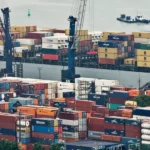
The Ministry of Labor is studying a Network Mechanism to save around “3,000” jobs in the automobile industry in the Valencian Community, the department directed by Yolanda Díaz reports to this medium. The measure aims to protect some “1,500 jobs” at the Ford factory in Almussafes, which is facing a traumatic end to the year, and another “1,500 indirect jobs” in the industrial fabric of the region, with the aim of avoiding layoffs and opting for the requalification of workers.
The second vice president and Minister of Labor met this Monday with the heads of Ford Spain and the Minister of Industry and Tourism, Jordi Hereu. After two collective layoffs since 2023, the Ford factory in Almussafes has implemented an ERTE for objective causes (ETOP) until December 31 and faces a very complicated 2025. The next two years are almost about survival until the arrival of the new hybrid model that will be produced exclusively in 2027.
For months now, the workforce has been requiring the Government to deploy a Network Mechanism, the new ERTE format created in the labor reform in the face of cyclical and sectoral crises, which are added to those that already existed (due to force majeure and economic causes). In this case, it would be a sectoral Network Mechanism, for the transition to electric vehicles, but also “geographically limited” to the Valencian Community, the Ministry indicates.
Obligation to train and industrial commitment
In Labor, the large number of jobs at risk stands out, about 3,000. During this Monday’s meeting with those responsible for Ford, Yolanda Díaz has shown “her commitment to saving every last job,” the Ministry explains, but being “very demanding that this commitment guarantee the industrial future of the Community.” “Valencian”.
The sectoral Network Mechanism is intended as a measure of internal flexibility “when in a certain sector or sectors of activity there are permanent changes that generate needs for requalification and professional transition processes of workers, with a maximum initial duration of one year. and the possibility of two extensions of six months each,” the law states.
In Labor they highlight that the Red Mechanism would force Ford and the rest of the affected companies to requalify the workers and, in addition, that it would imply greater protection for those affected, since it would entail the collection of the Red benefit, which is different from the Red benefit. of unemployment that is consumed in the ERTE ETOP and that many people are losing at this time.
For their part, companies have the right to exemptions in the payment of social contributions of workers in the Network Mechanism of 40%, conditional on the performance of training tasks.
It has to be approved by the Council of Ministers
The measure being studied by the Ministry of Yolanda Díaz is not guaranteed. It is still being analyzed and must be debated within the Government.
The Network Mechanism must be approved by the Council of Ministers, “at the joint proposal of the heads of the Ministries of Labor and Social Economy, of Economic Affairs and Digital Transformation, and of Inclusion, Social Security and Migration, following a report from the Commission Government Delegate for Economic Affairs”, as regulated by the labor reform. At the moment, only one Network Mechanism has been approved: the sectoral one for travel agencies after COVID.
From the second vice presidency they highlight that, “in this moment of transition to sustainable and green mobility in the automotive sector, the Government of Spain is decisively betting on electrified mobility, through Next Generation funds and other mechanisms to “strengthen the automotive sector of our country.”
Along these lines, in the labor sphere, Trabajo recalls that the Network Mechanism was approved as an instrument “so that this type of transitions would not entail a traumatic adjustment of the workforce and would encourage their training and retraining to gain productivity and competitiveness that now, especially suffering the effects of DANA, they prove vital to protect the industrial productive fabric in the Valencian Community.”
Source: www.eldiario.es

